The Corsair Force Series 3 is one of three current generation SSDs offered by Corsair. It’s nearly identical to their Force Series GT, both leverage a SATA 6Gb/s interface, SandForce SF-2281 processors and 25nm MLC NAND. The key difference is the Series 3 uses Asynchronous NAND where the GT uses Synchronous NAND. The difference gives the Series 3 a little better pricing flexibility, but that doesn’t mean performance takes a big hit. The Series 3 is still listed as cranking out 550MB/s read and 520MB/s write speeds.
Many manufacturers offer dueling SandForce enabled with Synchronous vs. Asynchronous NAND. Corsair obviously is one, but such configurations can also be found by OCZ (Vertex 3 vs. Agility 3) and Patriot (Pyro SE vs. Pryo). The goal with the Asynchronous SSDs is to drive the price down enough so the drives can appeal to the mainstream SSD audience; without giving up too much performance. This generally has been a successful approach thus far, which makes this class of SSDs quite appealing to a wide range of buyers.
To address the mainstream audience, Corsair is offering the Force Series 3 is pretty much every possible capacity including 60GB, 90GB, 120GB, 180GB, 240GB and 480GB. These multiple steps up in capacity give buyers incremental options when it comes to budget, making it easier to slot a Force 3 into a pre-defined spending limit. The savings thanks to the more cost effective NAND is immediately evident across the line, the popular 120GB capacity of the Force 3 for instance, currently carries a street price of $50 less than the Force GT. More globally, the Force Series 3 tends to carry street prices below those of other competing Asynchronous SandForce-based SSDs.
The Force 3 ships as a 2.5″ form factor, but Corsair includes a mounting bracket and screws for 3.5″ desktop bays. Corsair includes a three year warranty with the Force Series 3 SSDs.
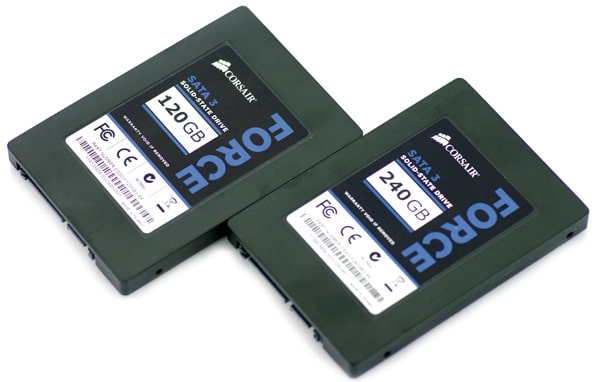
Corsair Force Series 3 Specs
- Capacities
- 60GB (CSSD-F60GB3-BK)
- 90GB (CSSD-F90GB3-BK)
- 120GB (CSSD-F120GB3-BK)
- 180GB (CSSD-F180GB3-BK)
- 240GB (CSSD-F240GB3-BK)
- 480GB (CSSD-F480GB3-BK)
- SandForce SF-2281 Processor
- 25nm Asynchronous IMFT NAND
- SATA 6Gb/s interface
- 550MB/s read speeds, 520MB/s write
- 85,000 IOPS (4K aligned)
- 2.5″ form factor (3.5″ bracket included)
- 60GB, 120GB and 240GB capacities
- Three year warranty
- Firmware Reviewed: 1.3.3
Aesthetics
Corsair really doesn’t hold anything back when it comes to the design of their SSDs. The Force 3 offers an all metal case with a matte black finish. Where other manufacturers have only gone the route of adjusting the color of the sticker, Corsair goes all out. Of course for most this paint won’t matter, but if you have one of the many see-through PC cases, the dark finish is a nice touch.
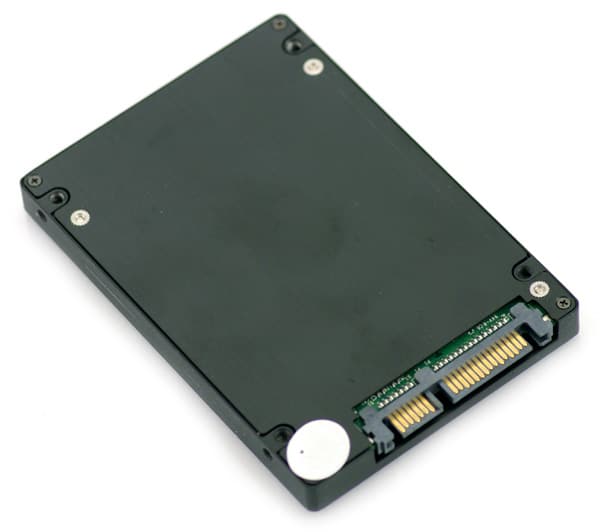
The Force 3 uses roughly the same all-metal case design as past models, with the exterior paint color and product sticker being the only significant changes. This design fits the 2.5-inch hard drive spec perfectly, fitting in every notebook drive back and drive sled we have on hand. Corsair also ships a bracket for fitting into 3.5″ drive bays.

The side profile of the drive shows the side mounting holes, which have some minimal paint overspray inside. In some ways this acts as a thread locker, helping to prevent screws from loosening over time, and in the same way causing slightly more effort to turn screws into place.
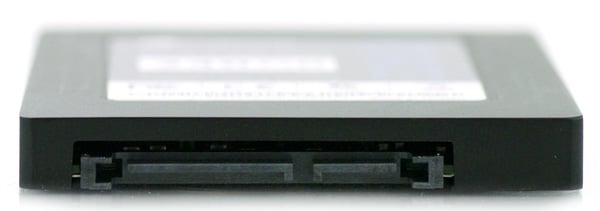
The front profile includes just the standard SATA power and data connection, with no service pins visible from the exterior.
Disassembly
Taking the Corsair Force 3 SSD apart is very simple, although the process of removing the top cover will void the warranty. There is no reason why the end user should ever open the case during normal operation, since even firmware updating can be done through a software interface. The first step in taking apart the Force 3 is removing the four fine-tipped Phillips head screws on the back cover. Once these are removed and the warranty stickers are broken, the cover lifts off exposing the circuit board inside.
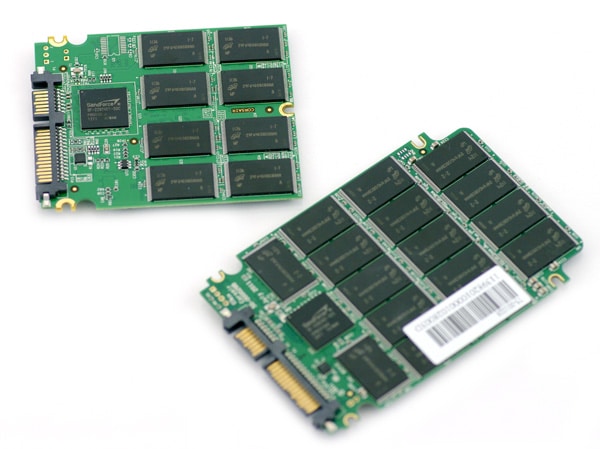
After the cover is removed, there are only four Phillips head screws remaining which hold the PCB to the case. After these are removed the board comes out completely.
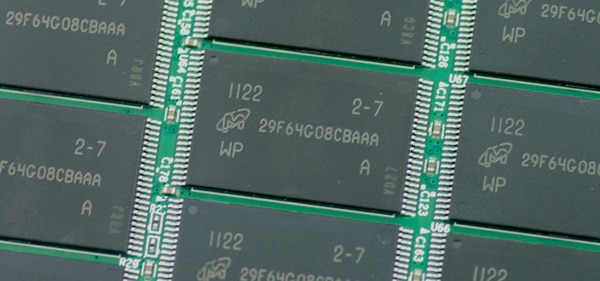
Corsair uses the SandForce SF-2281VB1-SDC or SF-2281VB1-SCC processor inside the Force 3 SSD depending on capacity. Offering SATA 6Gb/s saturating transfer speeds, this is the de facto controller on the market for any high-performance SSD.
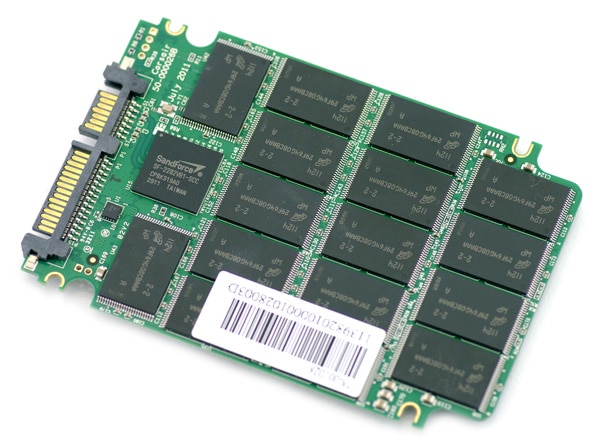
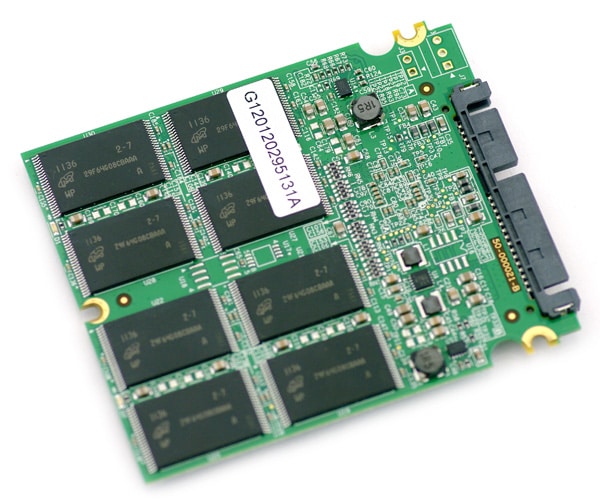
Depending on the capacity, Corsair uses either a 16 piece or 32 piece NAND configuration. In this case our 120GB Force 3 used the former and the 240GB used the latter. Both use 8GB Micron 29F64G08CBAAA asynchronous NAND internally.
Synthetic Benchmarks
Corsair positions the Force 3 series as a high performance mainstream SSD. Configured with asynchronous NAND, the Force 3 offers similar read speeds to the Force GT, but trades write speeds for affordability. This particular SSD is advertised as having 550MB/s read speeds and 520MB/s write speeds sequential, which we put to the test in our first synthetic benchmark.
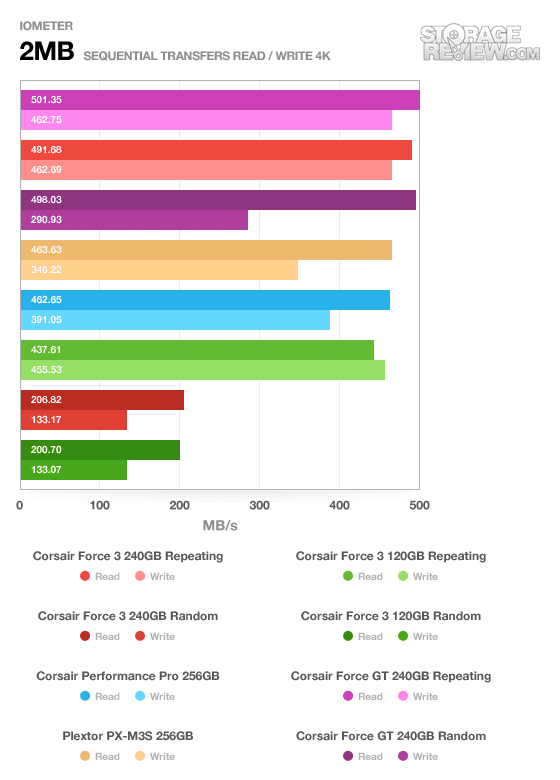
With repeating or compressible data we measured speeds of 491MB/s read and 462MB/s write on the 240GB Force 3, and 437MB/s read and 455MB/s on the 120GB Force 3. Moving to incompressible data both drives slowed substantially, down to 206MB/s read and 133MB/s write on the 240GB model and 200MB/s read and 133MB/s on the 120GB version.
Our next test looks at random 2MB transfers instead of sequential, showing what performance might look like during multiple file transfer requests.
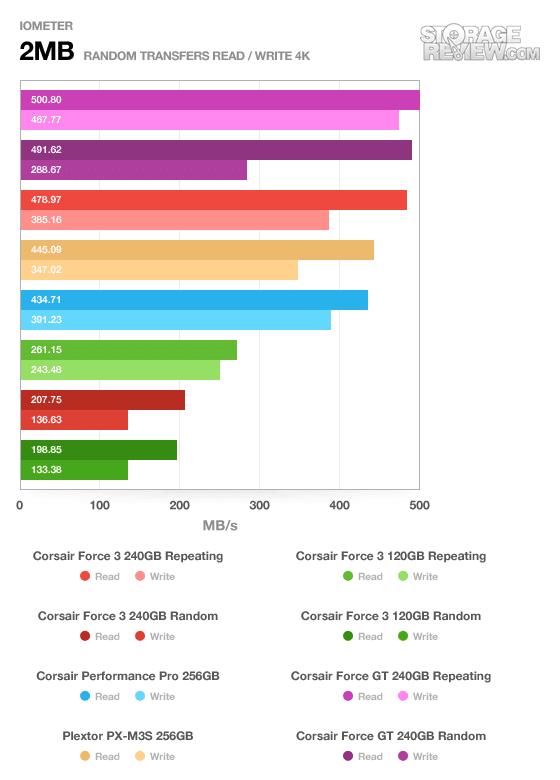
The 240GB Force 3 didn’t lose much speed, measuring 478MB/s read, but the 120GB model slowed to 261MB/s. Write speeds also dropped, to 385MB/s on the 240GB model and 243MB/s on the 120GB version. With incompressible data both drives measured above 200MB/s read and around 133MB/s write.
Moving on to even smaller transfer request sizes, our next section looks at random 4K read and write performance at a queue depth of one, and later moves to expanded queue depth tests.
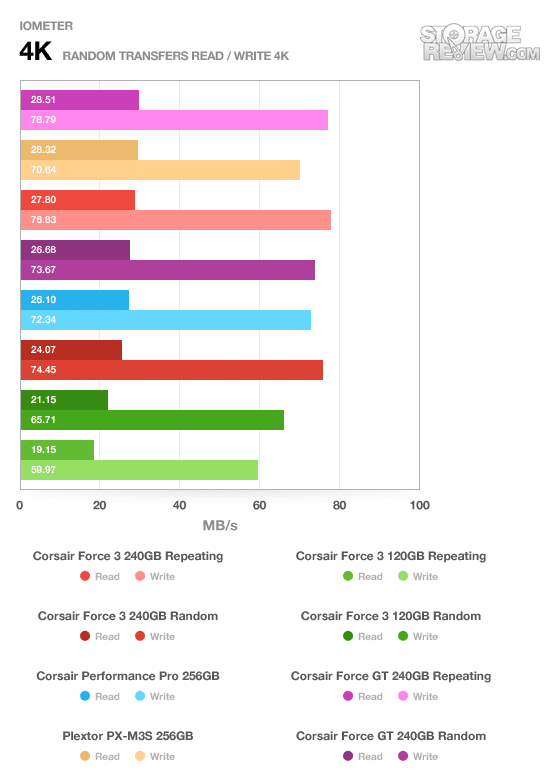
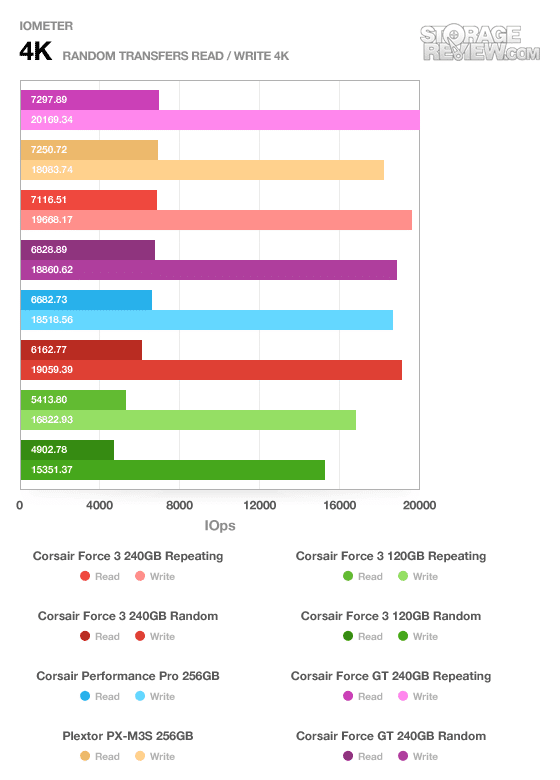
The 240GB Force 3 still maintained a strong lead above its smaller brother in the QD1 random 4K read and write test. It measured an average speed of 7116 IOPS read and 19669 IOPS write with compressible data which slowed to 6162 IOPS read and 19059 IOPS with randomized incompressible data. The smaller 120GB Force 3 measured an average speed of 5413 IOPS read and 16822 IOPS write with compressible data which slowed to 4902 IOPS read and 15351 IOPS with randomized incompressible data.
In our expanded 4K random read and write tests, we look how well each drive performed with multithreaded access.
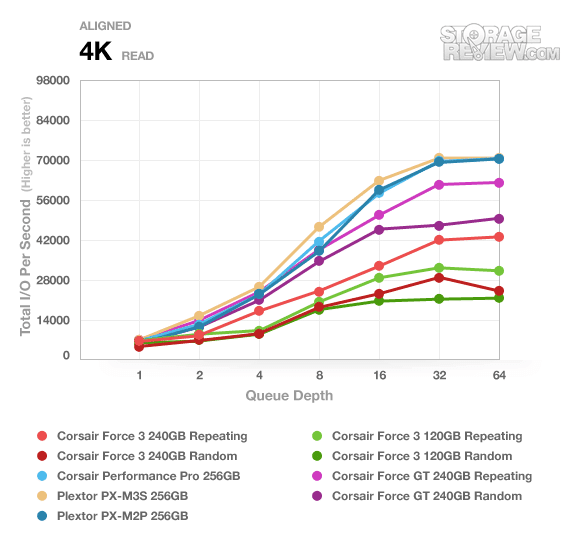
Both drives maintained a similar profile as what we have seen in previous tests, with the 240GB Force 3 having a lead in both areas above the 120GB Force 3 in random 4K read speeds. This changed in our next test when we switched to expanded write speeds.
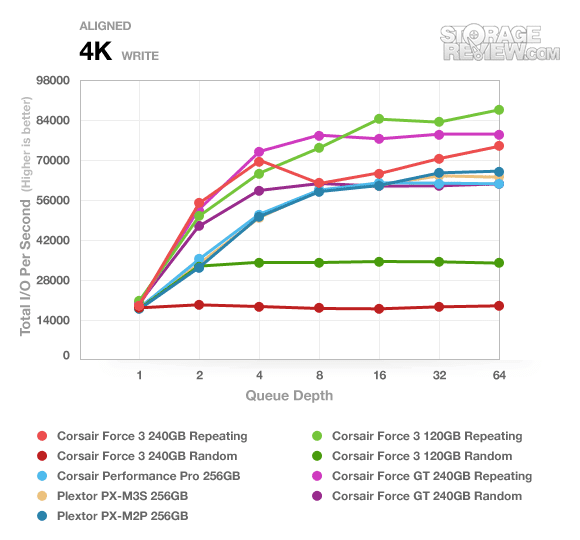
It was a bit of a surprise to see the 120GB Force 3 take a lead in the expanded 4K random write test, although firmware or the double NAND piece configuration could have been a contributing factor for the 240GB model.
In our 4K write latency test, which measures access times at a queue depth of 1, the 240GB Corsair Force 3 scored very close to the faster Force GT. In fact with both compressible and compressible data it either matched or was trailing by just 0.01ms.
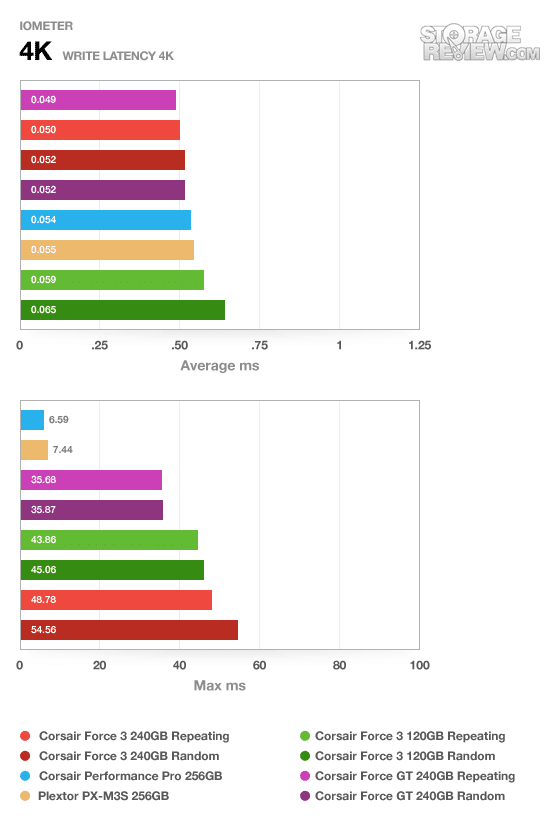
Using CrystalDiskMark with randomized data, we noted similar read and write speeds as what we found with our incompressible IOMeter testing.
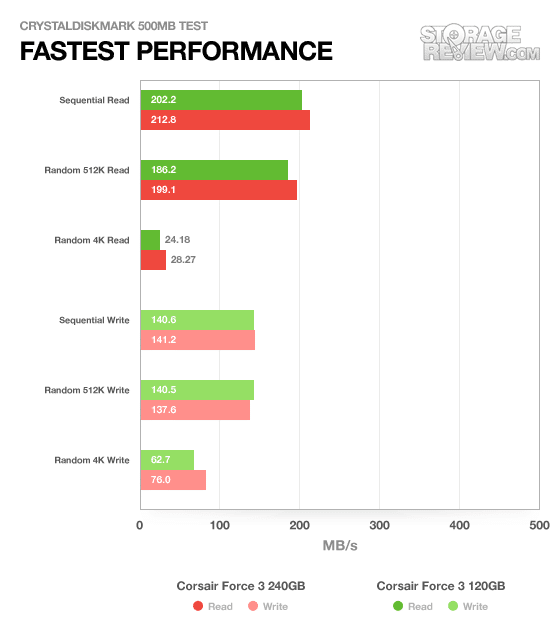
Our last group of consumer IOMeter synthetic benchmarks looks at mixed-load server profiles including Database, Workstation, File Server, and Webserver. In each of these tests the asynchronous NAND-equipped Force 3s trailed towards the bottom of this group, with the 240GB SSD leading over the 120GB model.
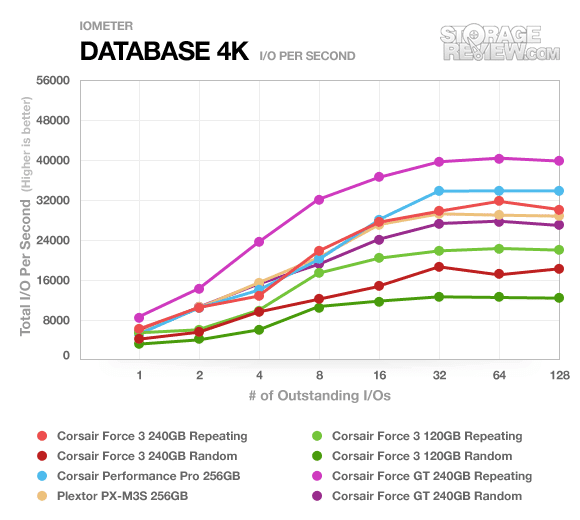
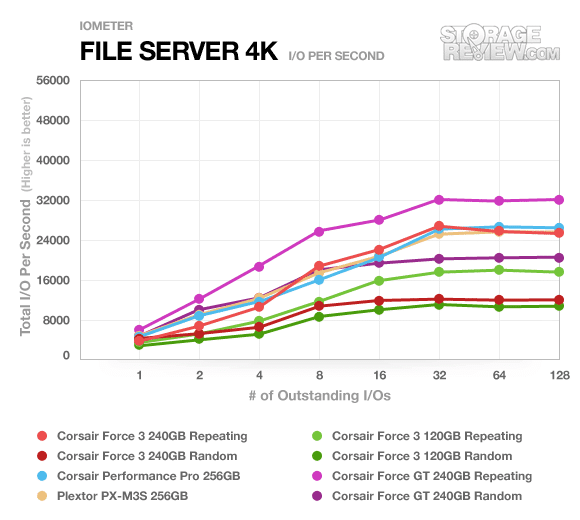
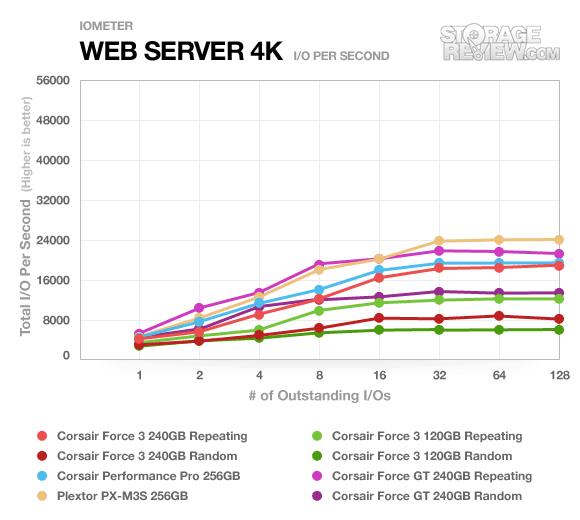
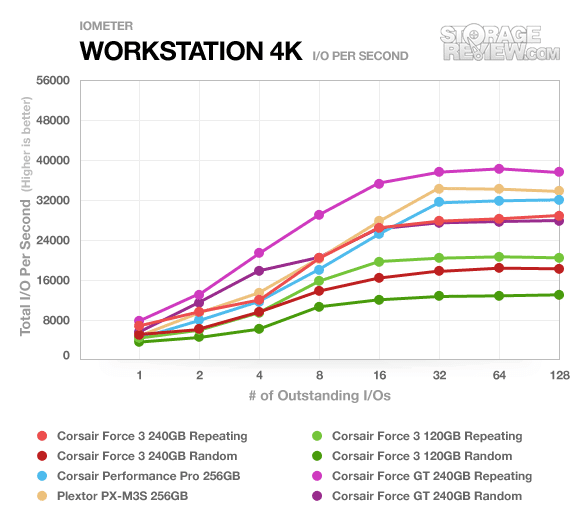
Enterprise Benchmarks
While we normally don’t include steady-state benchmarks in our consumer reviews, we felt it could offer some value to our readers to see how this drive might perform in an 24/7 continuous-write setting. Generally speaking only heavily-over provisioned drives can compete in this space, as well as models with heavy garbage collection algorithms that run at all times in the background to move around data as the drive fills up. Given this is our first look at this new platform and controller, we wanted to see how it stacked up in this space. The assortment of drives also compared includes the Micron C300 and P300 as well as the Plextor PX-M2P. The Micron P300 is the heavy-weight SLC-based enterprise drive in this test.
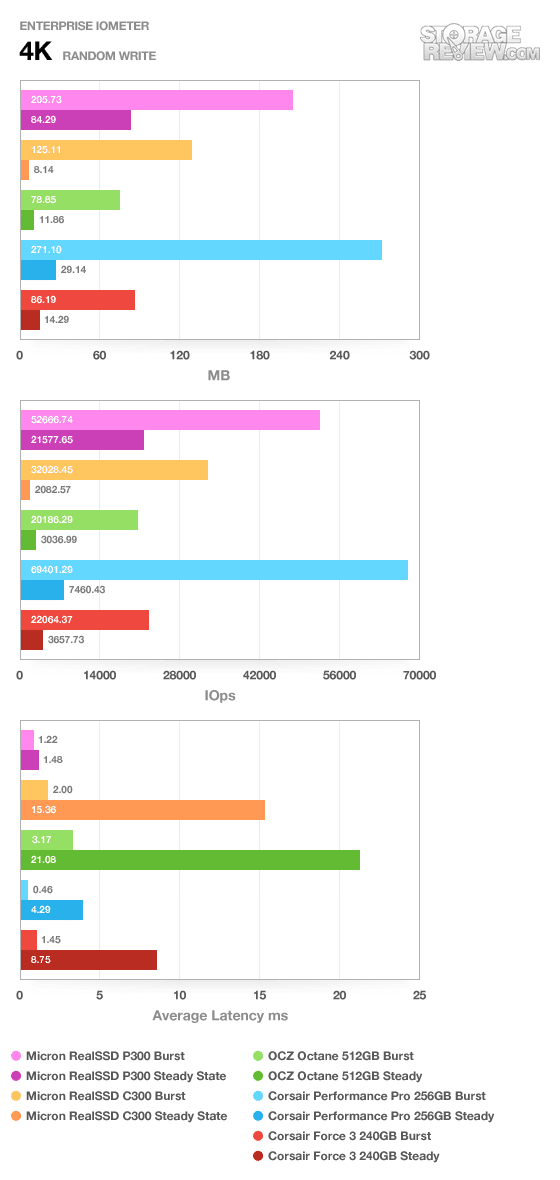
It’s a given that any drive put through the steady-state benchmark will have a significant performance drop between before and after. Comparing the consumer-targeted C300 to the enterprise-targeted P300, we notice a 60% drop on the P300 and 94.5% drop on the C300. Clearly the P300 held up better in a 24/7 write environment. To keep comparisons consistent we tested just the 240GB Force 3. It saw a drop of 83.4%, with a starting speed of 86.2MB/s and an ending speed of 14.9MB/s.
Real-World Benchmarks
If you are new to StorageReview, one thing we try to focus on is how any given drive might perform under real-world conditions. For the average user, trying to translate random 4K write speeds into an everyday situation is pretty difficult. It helps when comparing drives in every setting possible, but it doesn’t exactly work out into faster everyday usage or better game loading times. For this reason we turned to our StorageMark 2010 traces, which include HTPC, Productivity, and Gaming traces to help readers find out how a drive might rank under their conditions.
The first real-life test is our HTPC scenario. In this test we include: playing one 720P HD movie in Media Player Classic, one 480P SD movie playing in VLC, three movies downloading simultaneously through iTunes, and one 1080i HDTV stream being recorded through Windows Media Center over a 15 minute period. Higher IOps and MB/s rates with lower latency times are preferred. In this trace we recorded 2,986MB being written to the drive and 1,924MB being read.
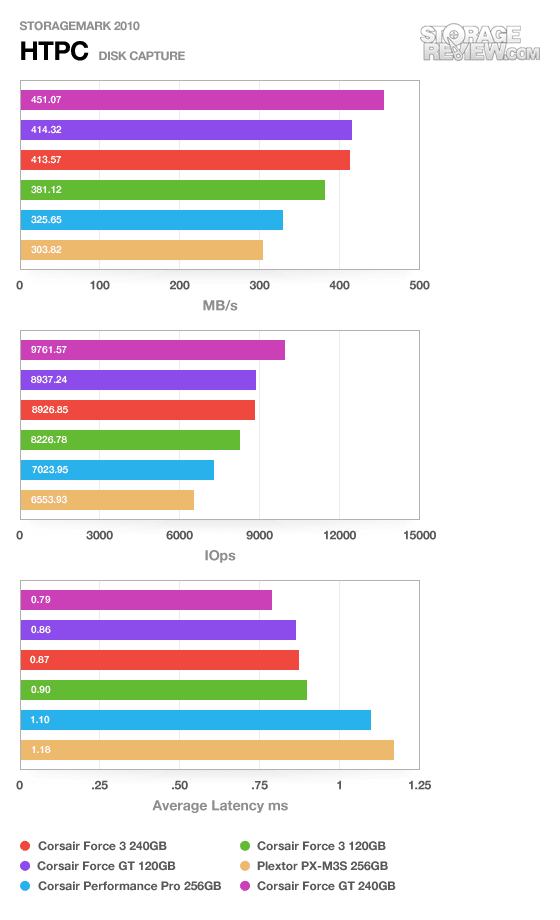
In our HTPC profile trace the 240GB Force 3 trailed the 240GB Force GT by 37.5MB/s while the 120GB models had a gap of 33.2MB/s.
Our second real-life test covers disk activity in a productivity scenario. For all intents and purposes this test shows drive performance under normal daily activity for most users. This test includes: a three hour period operating in an office productivity environment with 32-bit Vista running Outlook 2007 connected to an Exchange server, web browsing using Chrome and IE8, editing files within Office 2007, viewing PDFs in Adobe Reader, and an hour of local music playback with two hours of additional online music via Pandora. In this trace we recorded 4,830MB being written to the drive and 2,758MB being read.
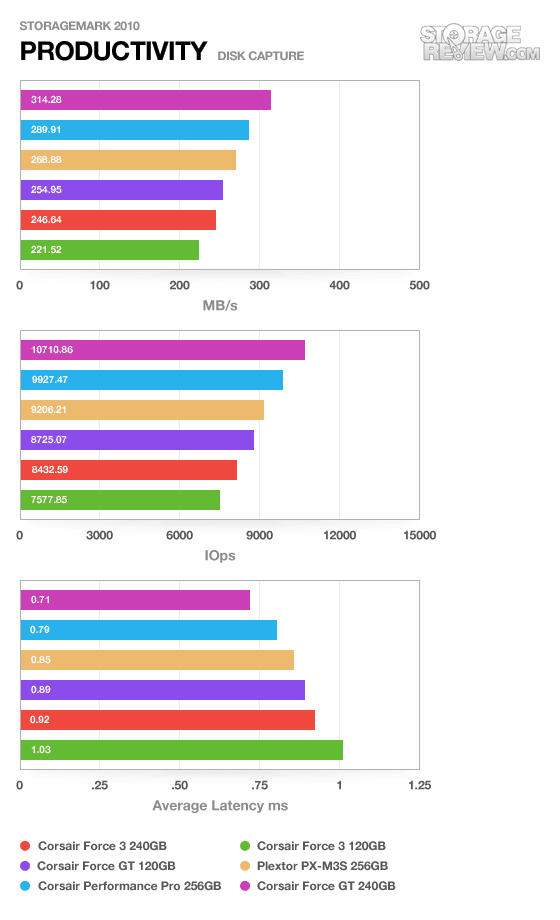
In our Productivity trace difference in speed was more apparent, with the 240GB force 3 trailing by 67.64MB/s and the 120GB Force 3 another 25MB/s below it.
Our third real-life test covers disk activity in a gaming environment. Unlike the HTPC or Productivity trace, this one relies heavily on the read performance of a drive. To give a simple breakdown of read/write percentages, the HTPC test is 64% write, 36% read, the Productivity test is 59% write and 41% read, while the gaming trace is 6% write and 94% read. The test consists of a Windows 7 Ultimate 64-bit system pre-configured with Steam, with Grand Theft Auto 4, Left 4 Dead 2, and Mass Effect 2 already downloaded and installed. The trace captures the heavy read activity of each game loading from the start, as well as textures as the game progresses. In this trace we recorded 426MB being written to the drive and 7,235MB being read.
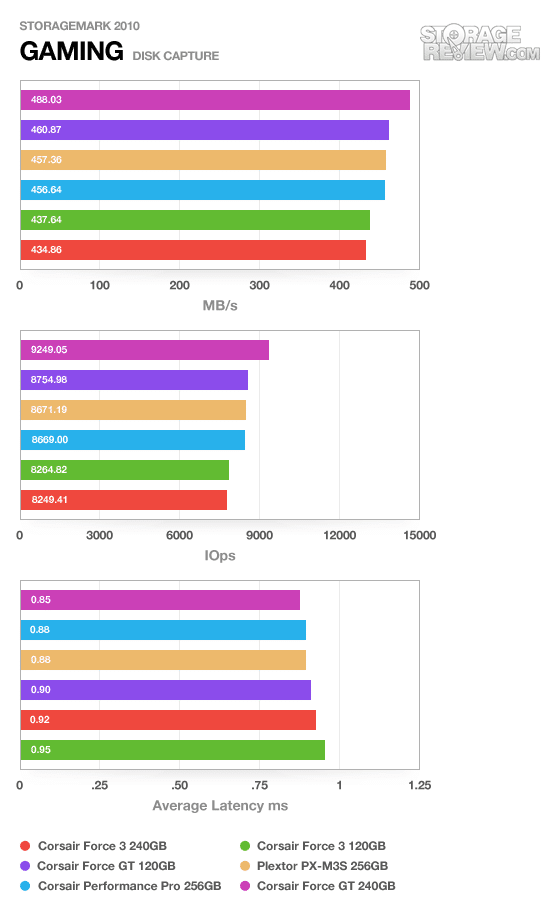
In our Gaming trace, centered heavily around read speeds, the Force 3 SSDs still provided very reasonable speeds compared to the faster drives on our charts. While each model trailed by roughly 50MB/s that made up only a 10% reduction in speed from the 240GB Force GT.
Power Consumption
With one of the main draws towards SSDs being their lower power consumption for the side effect of extended battery life in notebooks, we pay close attention to how much power these drives consume during our tests. Applying the same read and write profiles that we performed at the beginning of this review, we measure the power used by the SSD during these read or write profiles. Since SandForce models also heavily rely on compression for faster speeds and less write amplification, we measure power with both compressible and incompressible data.
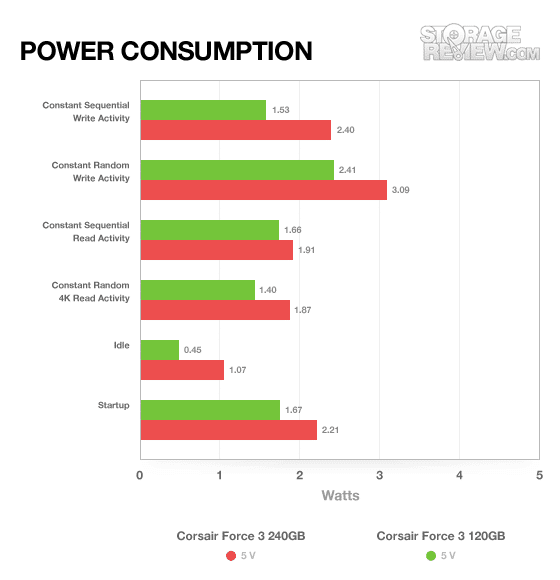
It was no surprise seeing the 32-chip 240GB Force 3 need more power in each of the power tests compared to the 16-chip 120GB Force 3. One of the biggest differences came in idle power consumption, where the larger model needed more than double the power (0.45 watts versus 1.07). In each of the other areas the 240GB model needed incrementally higher power, with a peak wattage of 3.09 watts in the incompressible write test.
Warranty
Corsair offers a three-year warranty on the Force 3-series SSDs. This is matched by all many other manufacturers except for Intel and OWC on select 25nm models.
Conclusion
The Corsair Force 3 SSDs performed as expected; in most cases the Corsair drives based on the SandForce SF-2200 controller with Asynchronous NAND came in close to the Force GT in heavy read activity, but slipped when heavy random writes were added to the equation. That said, the differences between the GT and Force 3 weren’t night and day, a good sign for those hoping to save a little money without giving up buckets of performance.
With solid performance, we turn to price as the other major differentiator. Corsair offers the Force Series 3 in several capacities ranging from 60GB to 480GB. The variety of steps gives buyers a little more control when it comes to budget. The Force 3 drives are priced generally in line with the competitors like the Agility 3, Pyro and Electra and the group is usually materially less expensive than their Synchronous-based cousins.
Overall if you are looking to save some money without losing too much performance, the Force Series 3 is a very good option if you still want to stick with a SandForce-equipped SSD. Unless you are working with heavily compressed files this drive still holds up well, especially with gaming where many enthusiasts look for increased performance.
Pros
- Good price/performance for mainstream SSD
- Modest power consumption
- Very strong performance if not dealing with fully compressed data
Cons
- Large speed drop with incompressible data
Bottom Line
The Corsair Force Series 3 uses lower cost Asynchronous NAND than the Force GT, but the Force 3 still manages to deliver very good performance for the mainstream SSD buyer. The Force 3 is an easy pick when users need big performance without a big price tag.




 Amazon
Amazon